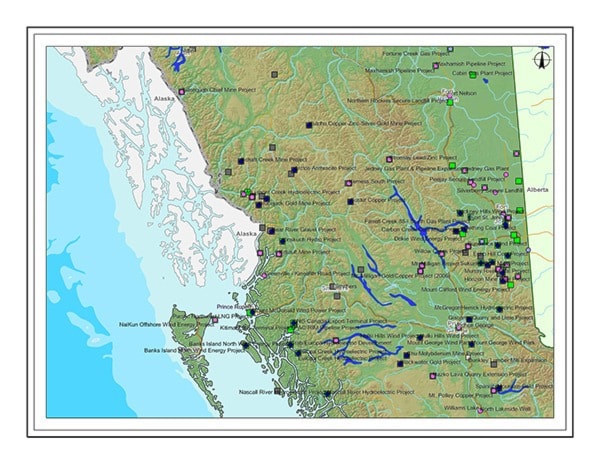Although gas and oil pipelines debates dominate the news with headline-grabbing radical rhetoric, they are a fraction of the total resource development planned for Northern B.C.
More than 29,000 people in B.C. find their employment in mining, with most of those numbers being located in rural communities. The 2011 average income for a mining employee was $115,700, up by seven per cent over the previous year.
Despite high salaries, it is a workforce facing labour shortages. In B.C., the mining sector alone expects to require an additional 16,770 workers within the next 10 years. Those workers will have to be found in competition with the oil and gas sectors in the same labour pool and facing the same labour shortages.
According to the Environmental Assessment Office (EAO), in the past 10 years 40 mining projects, representing almost $12.5 billion in investment, have come under environmental assessment for possible approval.
Most of those projects remain in pre-application stage, but 10 have already received the environmental green light. Among those close to the Lakes District are the Blackwater Gold project and the Mount Milligan mine expansion.
Energy projects, which include not only natural gas and oil exploration, but hydro-electric and wind power projects, account for 63 additional projects submitted for review to the EAO in the past 10 years. Those projects amount to more than $49.5 billion in investment dollars.
This isn’t to say that all these projects will necessarily go into the ground - or even that each one will be approved - but they do demonstrate the place that mining and energy extraction projects will play in B.C. and in the Northwest in particular.
Unlike mining projects which require a significantly large workforce, oil and gas projects have massive start-up labour requirements but taper off over the longer term.
For example, the 63 energy projects represent 43,000 person years of construction jobs, but only 3,800 longer-term operating jobs.
The 40 mining projects represent less than half the person-years of construction work, but they would provide over 93,000 operating jobs. With mineral mines often producing for more than 20 years, mining can bring long-term job stability to a region.
Despite the monetary and employment benefits of mining, new projects face significant expenses and hurdles before they reach construction phase. Mining is not a sure thing in B.C.
The provinces’ environmental assessment process considers potential short and long-term impacts on the environment and First Nations, among other qualifications.
Recently, Pacific Booker Mineral’s Morrison Copper and Gold mine project proposed for a location just north of Granisle, B.C., was denied an environmental assessment certificate after 10 years of preparatory work and an investment of $30 million.
Stock holders lost $140 million in share value. The company is currently suing to have the decision overturned and to be awarded damages.
British Columbia isn’t the only province where mining is playing a significant role in local and provincial economies. Those projects, even a province away, can impact local quality of life issues.
The Coalspur Mines Ltd. Vista coal mine project near Hinton Alberta, will be Canada’s largest-ever coal mine. Twelve million tonnes of cleaned-coal will be transported to terminals on B.C.’s west coast.
It is anticipated that Burns Lake will eventually see an additional six, 100-car trains per day as coal makes its way to the Ridley coal terminal in Prince Rupert.
With files from the
Interior News.
